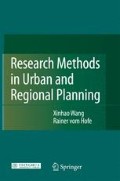Abstract
Planning is a profession that is concerned with shaping our living environment. (2000) observes that the profession of planning is alive and more plans have been made recently than ever before. As an example, a comprehensive plan sets the basis of land use policies and guides a community from where it is today to where we want it to be in the future. As the concept of sustainable development and the need for public involvement in planning by diverse groups become more widely accepted among politicians, policy-makers and the general public, it is critical to incorporate impact assessment and analysis into the planning and decision-making process. During such a process, planners bring stakeholders together (e.g., elected officials, business representatives, developers, community groups, residents, etc.) to set development goals and policies (e.g., what are we trying to achieve and how?). To do so, all stakeholders in a community should work together to analyze, compare, contrast and prioritize different development alternatives for a sustainable future (Smith et al., 2000; Wang, 2001). Planners, in particular, have the responsibility of gathering and evaluating available data, as well as accurately presenting future consequences of different action proposals to all stakeholders (Halls, 2001).
Access this chapter
Tax calculation will be finalised at checkout
Purchases are for personal use only
Preview
Unable to display preview. Download preview PDF.
References
Batty, M., M. Dodge, B. Jiang and A. Smith. 1999. Geographical Information Systems and urban design. In: J. Stillwell, S. Geertman and S. Openshaw (eds). Geographical Information and Planning. Berlin: Springer-Verlag.
Bracken, Ian. 1981. Urban Planning Methods: Research and Policy Analysis. London: Methuen & Co. Ltd.
Brail, Richard K. and Richard E. Klosterman (eds). 2001. Planning Support Systems: Integrating Geographic Information Systems, Models, and Visualization Tools. Redlands: ESRI Press.
Brail, Richard K. 1987. Microcomputers in Urban Planning and Management. New Brunswick, NJ: Rutgers, The State University of New Jersey.
Cartwright, Timothy J. 1993. Modeling the World in a Spreadsheet. Baltimore, MD: Johns Hopkins University Press.
Frenchman, Dennis. 2000. Planning shapes urban growth and development. In: Lloyd Bodwin and Bishwapriya Sanyal (eds). The Profession of City Planning. New Brunswick, NJ: Center for Urban Policy Research, Rutgers, The State University of New Jersey.
Halls, P.J. 2001. Geographic information science: innovation driven by application. Computers. Environment and Urban Systems, 25(1), 1–4.
Huxhold, William E., Patrick S. Tierney, David R. Turnpaugh, Bryan J. Maves and Kevin T. Cassidy. 1997. GIS County User Guide. New York: Oxford University Press.
Isserman, Andrew M. 2000. Economic base studies for urban and regional planning. In: Lloyd Bodwin and Bishwapriya Sanyal (eds.). The Profession of City Planning. New Brunswick, NJ: Center for Urban Policy Research, Rutgers, The State University of New Jersey.
Klosterman, Richard E. 1999. The what if? collaborative planning support system. Environment and Planning B: Planning and Design, 26: 393–408.
Singh, R. R. 1999. Sketching the city: a GIS-based approach. Environment And Planning B: Planning And Design, 26: 455–468.
Smith, J., J. Blake and A. Davies. 2000. Putting sustainability in place: sustainable communities projects in Huntingdonshire. Journal of Environmental Policy and Planning, 2(3): 211–223.
Wang, Xinhao. 2001. Integrating water quality management and land use planning in a watershed context. Journal of Environmental Management, 61(1): 25–36.
Rights and permissions
Copyright information
© 2007 Tsinghua University Press, Beijing and Springer-Verlag GmbH Berlin Heidelberg
About this chapter
Cite this chapter
(2007). Introduction: Planning Research Methods. In: Research Methods in Urban and Regional Planning. Springer, Berlin, Heidelberg. https://doi.org/10.1007/978-3-540-49658-8_1
Download citation
DOI: https://doi.org/10.1007/978-3-540-49658-8_1
Publisher Name: Springer, Berlin, Heidelberg
Print ISBN: 978-3-540-49657-1
Online ISBN: 978-3-540-49658-8
eBook Packages: Earth and Environmental ScienceEarth and Environmental Science (R0)

